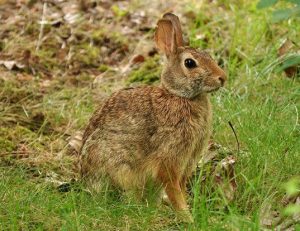Everything You Need To Know About Japanese Hares
Japanese hares are local to Japan. They are found over the main islands Honshu, Shikoku, and Kyushu. These hares populate mostly mountains or hilly areas. Additionally, they inhabit woodlands and brushy places. Hares are like rabbits and bunnies, but only bigger and faster, with longer legs and ears. In wintertime, their fur is thick and white (with black tips to the ears), but as the weather gets warmer and sunnier, hares shed and grow a lightweight brownish coat, more suitable for the summer. Their body length is from 45 to 54 cm.
Four subspecies exist in different parts of Japan. For example, Lepus brachyurus. Brachyurus is mostly found in mountains or hilly areas across all the main islands of Japan except Hokkaido. On the other hand, Lepus brachyurus angustidens found in Northern Honshu, Lepus brachyurus line found in Sado Island and Lepus brachyurus okiensis found in Oki Island. In regions of northern Japan, the west coast, and the island of Sado, where snowfall is heavy, the Japanese hare loses its coloration in the fall or autumn, remaining white until the springtime when the reddish-brown coat and fur return. In this article, we will look into Japanese Rabbits’ lifespan, lifestyle, and some other knowledge and whether they are worth your time and money or not.
Do Japanese Hares make good pets?
 Wild rabbits or known as hares don’t do well in captivity. Not only do their natural survival abilities prevent them from being suitable pets, but they spread dangerous diseases. Most bunnies become stressed and sad living in little cages and hutches. Keeping wild rabbits or hares is illegal in many areas. Hares are very difficult to tame, and several will kick and bite if you try to manage them. The rabbits that we keep as pets have not been living wild for several thousand years, and there are strong behavioral variations between wild hares and those that we keep in our homes.
Wild rabbits or known as hares don’t do well in captivity. Not only do their natural survival abilities prevent them from being suitable pets, but they spread dangerous diseases. Most bunnies become stressed and sad living in little cages and hutches. Keeping wild rabbits or hares is illegal in many areas. Hares are very difficult to tame, and several will kick and bite if you try to manage them. The rabbits that we keep as pets have not been living wild for several thousand years, and there are strong behavioral variations between wild hares and those that we keep in our homes.
Catching wild rabbits and managing and keeping them can be dangerous, especially after they could transmit the potentially deadly disease known as rabies in humans who overtake them. Not only this; but, wild rabbits will not be used to being in cages and handled by humans. It’s much better to attach to rabbits that have been born and bred in bondage.
What Do Japanese Hares Eat?
 Vegetation seen in and around its habitat is where the Japanese hare gets most of its nutrients. Greens, bushes, and hedges are all eaten by the hare. The Japanese hare is one of the few hares that will eat the peel off of trees. It does so occasionally which can cause great damage to trees and the jungle. Sometimes they will eat the bark from a bonsai tree in Asia. Hares are herbivores, with broad molars for grinding, a long intestine, and a single belly. So they will bite and chew their food once and proceed quickly.
Vegetation seen in and around its habitat is where the Japanese hare gets most of its nutrients. Greens, bushes, and hedges are all eaten by the hare. The Japanese hare is one of the few hares that will eat the peel off of trees. It does so occasionally which can cause great damage to trees and the jungle. Sometimes they will eat the bark from a bonsai tree in Asia. Hares are herbivores, with broad molars for grinding, a long intestine, and a single belly. So they will bite and chew their food once and proceed quickly.
Despite having microorganisms in their stomach to help ingest the tough cellulose of plant material, the food doesn’t stay around for a long time. To resolve the problem, hares reinvest their wastes. They produce two types of wastes which are soft green or black mucus-covered pellets, including vitamins, minerals, and fiber. Which is fed directly from the anus, and hard brown or tan pellets, which are fully digested. If hares are restricted from eating their feces, they bear and suffer a 15 to 25 percent decrease in growth.
How Big Are A Japanese Hares?
The Japanese hare is reddish-brown, with a body length that ranges from 45 to 54 cm (18 to 21 inches), and body weight of 1.3 to 2.5 kg (2.9 to 5.5 lbs). Its tail enlarges to lengths of 2 to 5 cm (0.79 to 1.97). Its front legs can be 10 to 15 cm (3.9 to 5.9 in) long and the back legs from 12 to 15 cm (4.7 to 5.9 in) long. The ears turn to be 6 to 8 cm (2.4 to 3.1 in) long, and the tail 2 to 5 cm (0.79 to 1.97 in) long.
Are Japanese Hares Aggressive?
 The most obvious reason hares will attack a person is that they are scared. While a rabbit’s first skill will be to run away and hide from anything that terrifies them, they can simply and quickly become aggressive and attack or push if they feel trapped. Most hares who regularly attack humans out of fear have seen that their aggressive behaviors will get people to go away. At first, they likely turned to lunge and bite out of desperation, feeling that there was no place to run. Following the aggressive behaviors that worked to get people to go away the first time, the rabbit learned to attack people more quickly. Eventually, this behavior becomes a way of making the rabbit aggressive to people all the time.
The most obvious reason hares will attack a person is that they are scared. While a rabbit’s first skill will be to run away and hide from anything that terrifies them, they can simply and quickly become aggressive and attack or push if they feel trapped. Most hares who regularly attack humans out of fear have seen that their aggressive behaviors will get people to go away. At first, they likely turned to lunge and bite out of desperation, feeling that there was no place to run. Following the aggressive behaviors that worked to get people to go away the first time, the rabbit learned to attack people more quickly. Eventually, this behavior becomes a way of making the rabbit aggressive to people all the time.
What’s The Average Lifespan Of A Japanese Hares?
The Japanese hare, a medium-sized herbivorous animal with a relatively short life span unusually living for more than 4 years, has been seen to be unaffected by actual landscape changes. Japanese hares can survive in fragmented local forests and are a key species in urban ecosystems based on their spot on the food chain.
How Fast Do Japanese Hares Grow?
 Japanese hares have a long breeding period, starting in early January and ending in August. The amount of litter by season ranges from 4 to 5. The average litter size ranges from 1 to 4, with 1.6 babies being the average and the standard weight of the young at birth is 132 g. There is a single rate of males to females born in each litter. Within one breeding season, a normal female will average 7.4 young. The weaning season typically takes place 2 to 3 weeks after birth.
Japanese hares have a long breeding period, starting in early January and ending in August. The amount of litter by season ranges from 4 to 5. The average litter size ranges from 1 to 4, with 1.6 babies being the average and the standard weight of the young at birth is 132 g. There is a single rate of males to females born in each litter. Within one breeding season, a normal female will average 7.4 young. The weaning season typically takes place 2 to 3 weeks after birth.
Female hares grow sexually mature at ten months old. The gestation period ranges from 43 to 45 days and the period among births ranges from 33 to 109 days. A birthing period shorter than the growth period suggests the chance of superfoetation. This is more confirmed by the existence of postcoital ovulation in Japanese hares. At the other end of the spectrum, there can also be delays between birth and the next mating. Sometimes female Japanese hares will follow and chase away males with whom they do not want to breed.
How Do You Bond With A Japanese Hares?
 Probably not. Because wild rabbits are a prey species, it takes a more deliberate advance on your part to build a relationship with a wild rabbit. Compared to a human, rabbits are small but depend on what types of rabbits that you keep as a pet such as wild rabbits or hares. Most of the moment it’s our toes and legs in their field of view. It’s hard to build a relationship with a pair of legs. To build a relationship with your rabbit you’ve got to get on an equal level. Sit or lie down on the floor.
Probably not. Because wild rabbits are a prey species, it takes a more deliberate advance on your part to build a relationship with a wild rabbit. Compared to a human, rabbits are small but depend on what types of rabbits that you keep as a pet such as wild rabbits or hares. Most of the moment it’s our toes and legs in their field of view. It’s hard to build a relationship with a pair of legs. To build a relationship with your rabbit you’ve got to get on an equal level. Sit or lie down on the floor.
Final Thought
To conclude, the Japanese hare is one of the most interesting and rare animals. Through reading and studying their lifespan, diet, description, habitat, we hope that you can learn and understand how Japanese Hare lives and help them survive and not become extinct.
https://www.rabbitproducersassociation.com/everything-you-need-to-know-about-japanese-hares/https://www.rabbitproducersassociation.com/wp-content/uploads/2021/06/Japanese-Hares.jpghttps://www.rabbitproducersassociation.com/wp-content/uploads/2021/06/Japanese-Hares-150x150.jpgUncategorizedJapanese hares are local to Japan. They are found over the main islands Honshu, Shikoku, and Kyushu. These hares populate mostly mountains or hilly areas. Additionally, they inhabit woodlands and brushy places. Hares are like rabbits and bunnies, but only bigger and faster, with longer legs and ears. In...FizleenFizleen fizleenmazlanx@gmail.comAuthorNetherland Dwarf Rabbit


Leave a Reply